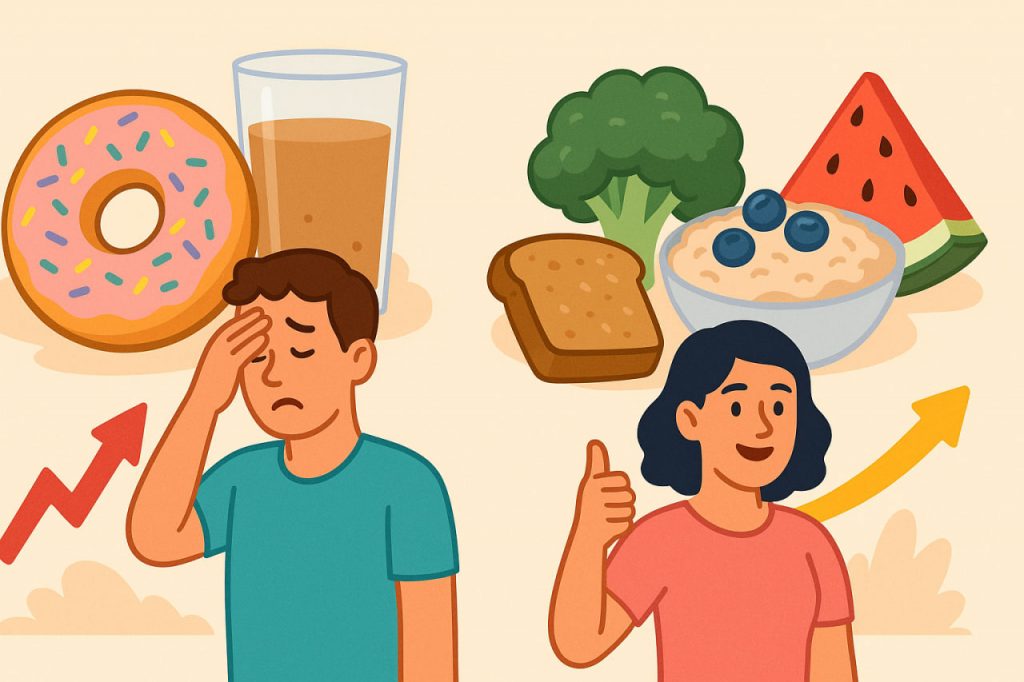The glycemic index (GI) is a scale that ranks carbohydrate-containing foods by how quickly they raise blood glucose levels after consumption. It provides insight into how the body processes various types of carbohydrates and how they impact energy levels, appetite regulation, and fat storage. Understanding the glycemic index can help individuals make informed dietary choices, particularly in relation to weight management, metabolic health, and sustained physical or mental performance.
What Is the Glycemic Index?
The glycemic index ranks foods on a scale from 0 to 100 based on their effect on postprandial blood sugar. Foods with a high GI (above 70) cause rapid spikes in glucose, while those with a low GI (below 55) lead to gradual increases. This classification is determined by comparing a food’s effect on blood sugar to that of pure glucose.
Examples of high-GI foods include white bread, sugary cereals, and baked potatoes, while low-GI foods include lentils, whole oats, and most non-starchy vegetables. However, the GI of a food can be affected by factors such as ripeness, cooking method, and food combination in a meal.
Impact on Energy Levels and Fatigue
High-GI foods provide a quick burst of energy due to a sharp increase in glucose availability, but this is often followed by a rapid drop in blood sugar—known as reactive hypoglycemia—which can result in fatigue, irritability, and hunger shortly after eating. This pattern can lead to energy instability and reduced concentration.
In contrast, low-GI foods support stable glucose release, resulting in sustained energy levels over time. This makes them especially beneficial for individuals engaging in prolonged cognitive or physical tasks, such as studying, working, or athletic performance.
Glycemic Index and Weight Management
Consistently consuming high-GI foods stimulates excess insulin secretion, which promotes fat storage, especially in the abdominal region. Elevated insulin levels also suppress lipolysis—the breakdown of stored fat for energy—making it harder to lose weight.
Low-GI diets are associated with better appetite regulation, lower caloric intake, and improved satiety. They may reduce cravings and prevent overeating by slowing gastric emptying and modulating hunger-related hormones such as ghrelin and leptin.
Effect on Insulin Sensitivity and Disease Risk
Long-term consumption of high-GI foods is linked to increased risk of type 2 diabetes, obesity, cardiovascular disease, and metabolic syndrome. These foods create repeated glucose spikes that stress pancreatic beta cells, reducing insulin sensitivity over time.
Low-GI diets help improve glycemic control in both healthy individuals and people with pre-diabetes or insulin resistance. They are often used therapeutically to manage blood sugar fluctuations and reduce inflammatory markers in the bloodstream.
Limitations of the Glycemic Index Concept
While useful, the glycemic index does not account for portion size or total carbohydrate content. A food with a low GI can still raise blood sugar significantly if eaten in large quantities. The glycemic load (GL) addresses this by considering both the GI and the amount of carbohydrate in a typical serving.
Additionally, individual responses to the same food can vary depending on factors such as gut microbiota, physical activity, and metabolic health. Therefore, GI should be considered alongside overall dietary quality and context.
Conclusion
The glycemic index is a valuable tool for understanding how foods influence blood sugar, energy levels, and body weight. Prioritizing low-GI foods can lead to improved metabolic outcomes, sustained vitality, and better long-term weight regulation. However, a balanced diet that incorporates nutrient-dense whole foods, regardless of GI, remains the foundation of healthful eating.
Glossary
- Glycemic index (GI) — a ranking of foods based on their effect on post-meal blood sugar levels.
- Insulin — a hormone that regulates glucose uptake and fat storage.
- Reactive hypoglycemia — a rapid drop in blood sugar following a spike.
- Lipolysis — the breakdown of fat for energy.
- Glycemic load (GL) — an index that considers both the GI and the quantity of carbohydrates consumed.
- Satiety — the feeling of fullness that reduces the desire to eat.
- Beta cells — insulin-producing cells in the pancreas.
- Insulin resistance — a condition in which cells respond poorly to insulin, increasing disease risk.


